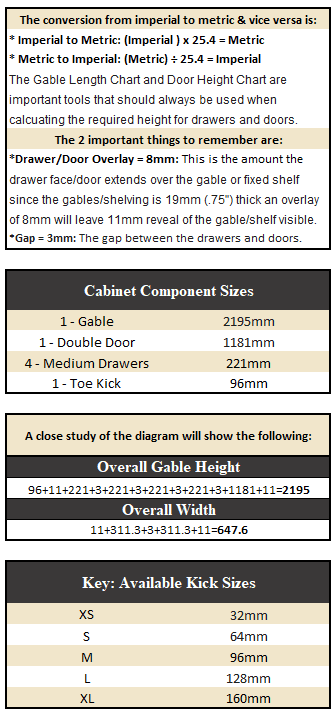Learning how to manually calculate the correct cabinet (gable) height for any combination of doors and/or drawers is important. It is recommended when calculating these items, that it be done in metric measurements.


Understanding and Applying the 32 mm System for Cabinet Height Calculations
The 32 mm system is a standardized method used in cabinet manufacturing to ensure consistent spacing, predictable hole locations, and simplified construction. Once you understand the relationship between reveals, gaps, drawer fronts, and door heights, you can easily calculate the overall height of a cabinet—or work backward from a required height to determine what combination of components will fit.
How the Calculation Method Works
Every cabinet is made up of stacked components: kick (toe kick), reveals, drawer fronts, gaps, doors, and top/bottom structural parts. When you add together the exact measurements of each piece—including every reveal and gap—you arrive at the cabinet’s total gable height.
The example above shows this sequence:
- Kick: 96 mm
- Bottom Fixed Shelf Reveal: 11 mm
- Medium Drawer: 221 mm
- Gap: 3 mm
- Medium Drawer: 221 mm
- Gap: 3 mm
- Medium Drawer: 221 mm
- Gap: 3 mm
- Medium Drawer: 221 mm
- Gap: 3 mm
- Double Door: 1181 mm
- Top Fixed Shelf Reveal: 11 mm
When you add all of these components together, you get the total cabinet (gable) height:
2195 mm.
This method works because each component aligns with the 32 mm system: door and drawer sizes are designed around increments of 32 mm, and standard spacing practices (3 mm gaps, 11 mm reveals) maintain visual consistency and functional clearance.
Why Metric Simplifies the Process
The 32 mm system itself is metric-based. While you can convert between imperial and metric, calculations become more complex in inches because they require frequent rounding. Using millimeters keeps each part aligned with the system’s original design and ensures that your summed dimensions remain accurate and consistent.
Even if customers or builders think in inches, the cabinet manufacturing math is far cleaner in millimeters, which is why we recommend performing all calculations in metric and converting only if needed.
Using This Method to Determine Cabinet Height — or to Work Backward
This calculation method is versatile. You can use it in two ways:
1. Calculate the Cabinet (Gable) Height Based on the Components
If you already know the drawer and door arrangement you want, simply add:
- Kick height
- All reveals
- All drawer-front heights
- All door heights
- All gaps between components
The resulting number is your finished gable height.
This is helpful for:
- Producing shop drawings
- Estimating material use
- Ensuring consistency between cabinets
- Providing customers with accurate size confirmations
2. Start with a Required Cabinet Height to Determine the Component Combination
You can also work backward. If you have a fixed cabinet height—for example,
2195 mm—you can select drawer and door combinations that fit into this height while respecting the required gaps and reveals.
Your available drawer-front heights (based on the 32 mm system) are:
- Extra Small Drawer: 125 mm
- Small Drawer: 157 mm
- Small Medium Drawer: 189 mm
- Medium Drawer: 221 mm
- Medium Large Drawer: 253 mm
- Large Drawer: 285 mm
- Extra Large Drawer: 317 mm
Doors can also be calculated to match the remaining vertical space once drawer heights, reveals, gaps, and kicks are accounted for. Because the 32 mm system ensures that door heights are modular, you can mix and match until the total equals your target cabinet height.
This reverse-engineering approach helps you:
- Design custom cabinets to fit exact openings
- Build cabinetry around appliances
- Maintain alignment with other cabinets in the run
- Generate consistent product offerings within your catalog
Summary of Benefits
- Accuracy: Every gap and reveal is accounted for, preventing installation issues.
- Flexibility: Build a cabinet to fit a layout, or design the layout to fit the cabinet.
- Standardization: Aligns perfectly with 32 mm construction patterns and hardware locations.
- Adaptability: Works for both metric and imperial workflows (metric recommended).
For more information you can view a related article and video explaining how to Calculate Drawer Bank Heights – KCD Software.

